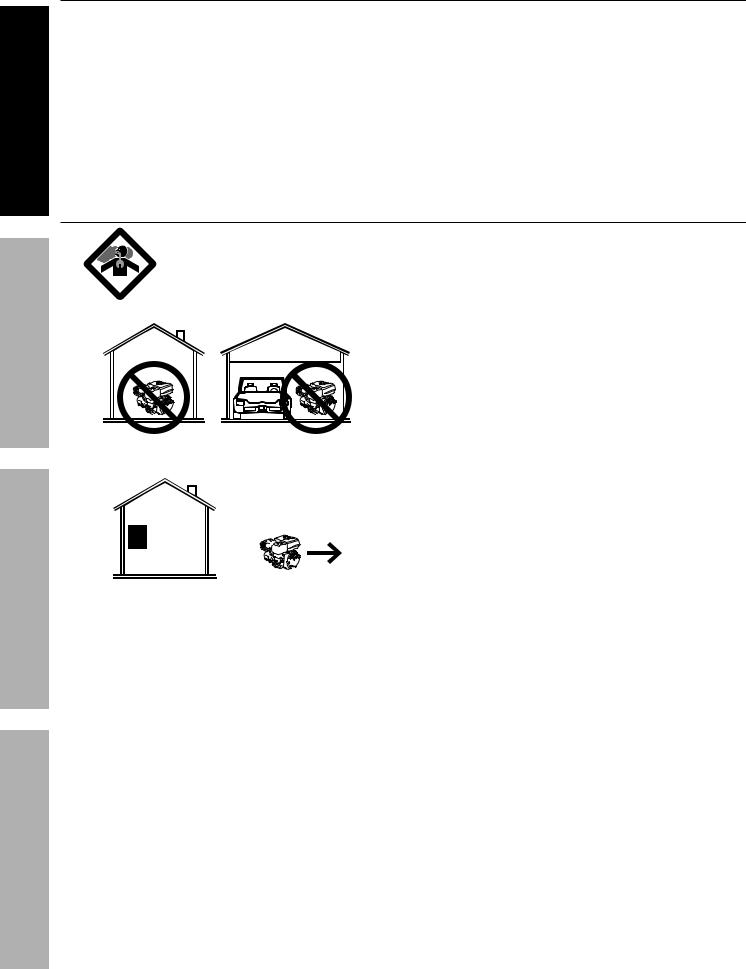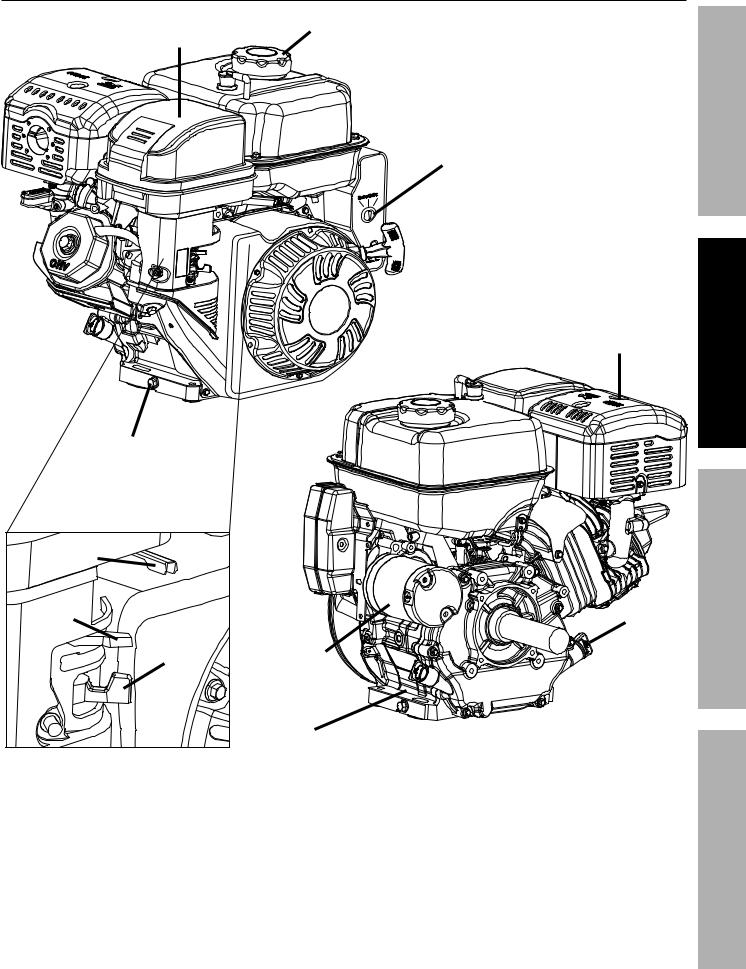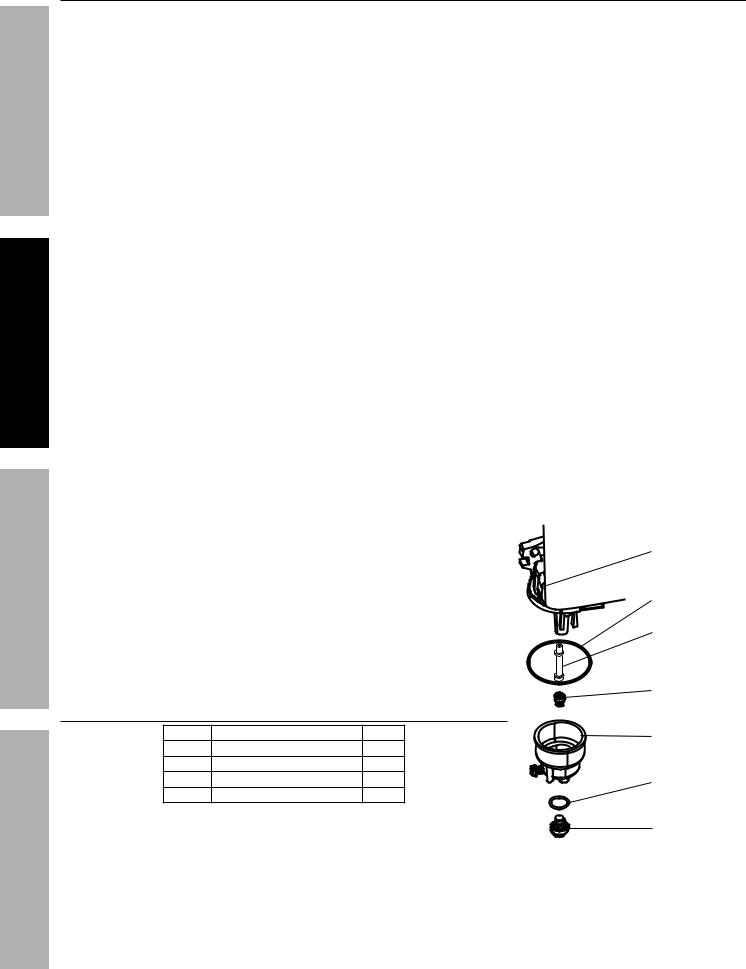Harbor Freight Tools 69736 Product manual

Owner’s Manual & Safety Instructions
Save This Manual Keep this manual for the safety warnings and precautions, assembly, operating, inspection, maintenance and cleaning procedures. Write the product’s serial number in the back of the manual near the assembly diagram (or month and year of purchase if product has no number). Keep this manual and the receipt in a safe and dry place for future reference.
420cc
Horizontal Engine
Using an engine indoors
CAN KILL YOU IN MINUTES.
Engine exhaust contains carbon monoxide.
This is a poison you cannot see or smell.
NEVER use inside |
Only use OUTSIDE |
a home or garage, |
and far away from |
EVEN IF doors and |
windows, doors, |
windows are open. |
and vents. |
|
|
Visit our website at: http://www.harborfreight.com Email our technical support at: predator@harborfreight.com
ITEM 69736
When unpacking, make sure that the product is intact and undamaged. If any parts are missing or broken, please call 1-888-866-5797 as soon as possible.
Copyright© 2012 by Harbor Freight Tools®. All rights reserved.
No portion of this manual or any artwork contained herein may be reproduced in any shape or form without the express written consent of Harbor Freight Tools.
Diagrams within this manual may not be drawn proportionally. Due to continuing improvements, actual product may differ slightly from the product described herein.
Tools required for assembly and service may not be included.
Read this material before using this product. Failure to do so can result in serious injury. SAVE THIS MANUAL.

Table of Contents
Specifications.............................................. |
2 |
Maintenance............................................... |
14 |
Safety.......................................................... |
3 |
Troubleshooting......................................... |
18 |
Setup........................................................... |
6 |
Warranties.................................................. |
23 |
Operation.................................................... |
9 |
Parts List and Diagram............................... |
20 |
Specifications
Displacement |
|
420cc |
|
Engine Type |
|
Horizontal Single Cylinder 4 stroke OHV |
|
|
EPA phase III compliant |
||
|
|
||
Cooling System |
|
Forced air cooled |
|
|
Type |
87+ octane stabilizer treated |
|
Fuel |
unleaded gasoline |
||
|
|||
|
Capacity |
1 Gallon |
|
|
Type SAE |
10W-30 above 32° F |
|
Engine Oil |
5W30 at 32° F or below |
||
|
|||
|
Capacity |
1.16 Quart |
|
Run Time @ 50% Load |
3 hr. |
||
with full tank |
|
||
|
|
||
Sound Level at 22 feet |
108 dB |
||
Bore x Stroke |
|
90 mm x 66 mm |
|
Compression Ratio |
|
8.5:1 |
|
Rotation viewed from PTO |
Counterclockwise |
||
(power takeoff - the output shaft) |
|||
|
|||
|
Shaft |
1″ x 3.48″ |
|
Shaft |
Keyway |
1/4″ (6.35 mm) |
|
|
End Tapped |
3/8″ - 24 |
|
Spark Plug |
Type |
NHSP® / Torch® F6TC |
|
Gap |
0.7 - 0.8 mm |
||
|
|||
Valve Clearance |
Intake |
0.10 - 0.15 mm |
|
Exhaust |
0.15 - 0.20 mm |
||
|
|||
Speed |
Idle |
1,800 ± 50 RPM |
|
Page 2 |
For technical questions, please call 1-888-866-5797. |
ITEM 69736 |

WARNING SYMBOLS AND DEFINITIONS
This is the safety alert symbol. It is used to alert you to potential personal injury hazards. Obey all safety messages that
follow this symbol to avoid possible injury or death.
Indicates a hazardous situation which, if not avoided, will result in death or serious injury.
Indicates a hazardous situation which, if not avoided, could result in death or serious injury.
Indicates a hazardous situation which, if not avoided, could result in minor or moderate injury.
Addresses practices not related to personal injury.
Symbol Definitions
Symbol |
Property or Statement |
RPM |
Revolutions Per Minute |
|
|
HP |
Horsepower |
|
|
|
WARNING marking concerning |
|
Risk of Eye Injury. Wear ANSI-approved |
|
safety goggles with side shields. |
|
Read the manual before |
|
set-up and/or use. |
|
|
|
WARNING marking concerning |
|
Risk of Hearing Loss. |
|
Wear hearing protection. |
Symbol |
Property or Statement |
|
WARNING marking concerning |
|
Risk of Respiratory Injury. |
|
Operate engine OUTSIDE and far away |
|
from windows, doors, and vents. |
|
WARNING marking concerning |
|
Risk of Fire while handling fuel. |
|
Do not smoke while handling fuel. |
|
WARNING marking concerning |
|
Risk of Fire. |
|
Do not refuel while operating. |
|
Keep flammable objects |
|
away from engine. |
Safety Warnings
WARNING! Read all instructions.
Failure to follow all instructions listed below may result in fire, serious injury and/or DEATH.
The warnings and precautions discussed in this manual cannot cover all possible conditions and situations that may occur. It must be understood by the operator that common sense and caution are factors which cannot be built into this product, but must be supplied by the operator.
SAVE THESE INSTRUCTIONS
Safety
Setup
Operation
Maintenance
ITEM 69736 |
For technical questions, please call 1-888-866-5797. |
Page 3 |

afetyS
etuS p
erationOp
aintenanceM
Set up Precautions
1.Gasoline fuel and fumes are flammable, and potentially explosive. Use proper fuel storage and handling procedures. Do not store fuel or other flammable materials nearby.
2.Have multiple ABC class fire extinguishers nearby.
3.Operation of this equipment may create sparks that can start fires around dry vegetation. A spark arrestor may be required. The operator should contact local fire agencies for laws or regulations relating to fire prevention requirements.
4.Set up and use only on a flat, level, well ventilated surface.
5.Wear ANSI-approved safety goggles, heavy-duty work gloves, and dust mask/respirator during set up.
6.Use only lubricants and fuel recommended in the Specifications chart of this manual.
Operating Precautions
1.CARBON MONOXIDE HAZARD Using an engine indoors CAN KILL
YOU IN MINUTES.
Engine exhaust contains carbon monoxide. This is a poison you cannot see or smell.
NEVER use inside a home or garage,
EVEN IF doors and windows are open.
Only use OUTSIDE and far away from windows, doors, and vents.
2.Keep children away from the equipment, especially while it is operating.
3.Keep all spectators at least six feet from the Engine during operation.
4.Fire Hazard! Do not fill gas tank while engine is running. Do not operate if gasoline has been spilled. Clean spilled gasoline before starting engine.
Do not operate near pilot light or open flame.
5.Do not touch engine during use. Let engine cool down after use.
6.Never store fuel or other flammable materials near the engine.
7.Only use a suitable means of transport and lifting devices with sufficient weight bearing capacity when transporting the Engine.
8.Secure the Engine on transport vehicles to prevent the tool from rolling, slipping, and tilting.
9.Industrial applications must follow OSHA requirements.
10.Do not leave the equipment unattended when it is running. Turn off the equipment (and remove safety keys, if available) before leaving the work area.
11.Engine can produce high noise levels. Prolonged exposure to noise levels above 85 dBA is hazardous to hearing. Always wear ear protection when operating or working around the gas engine while it is operating.
12.Wear ANSI-approved safety glasses, hearing protection, and NIOSH-approved dust mask/ respirator under a full face shield along
with steel-toed work boots during use.
13.People with pacemakers should consult their physician(s) before use. Electromagnetic fields in close proximity to a heart pacemaker could cause pacemaker interference or pacemaker failure. Caution is necessary when near the
engine’s magneto or recoil starter.
14.Use only accessories that are recommended by Harbor Freight Tools for your model. Accessories that may be suitable for one piece of equipment may become hazardous when used on another piece of equipment.
15.Do not operate in explosive atmospheres, such as in the presence of flammable liquids, gases, or dust. Gasoline-powered engines may ignite the dust or fumes.
16.Stay alert, watch what you are doing and use common sense when operating this piece of equipment. Do not use this piece of equipment while tired or under the influence of drugs, alcohol or medication.
17.Do not overreach. Keep proper footing and balance at all times. This enables better control of the equipment in unexpected situations.
18.Use this equipment with both hands
only. Using equipment with only one hand can easily result in loss of control.
19.Dress properly. Do not wear loose clothing or jewelry. Keep hair, clothing and gloves away from moving parts. Loose clothes, jewelry or long hair can be caught in moving parts.
Page 4 |
For technical questions, please call 1-888-866-5797. |
ITEM 69736 |

Operating Precautions (cont.)
20.Parts, especially exhaust system components, get very hot during use. Stay clear of hot parts.
21.Do not cover the engine or equipment during operation.
22.Keep the equipment, engine, and surrounding area clean at all times.
23.Use the equipment, accessories, etc., in accordance with these instructions and in the manner intended for the particular type of equipment, taking into account the working conditions and the work to be performed. Use of the equipment for operations different from those intended could result in a hazardous situation.
24.Do not operate the equipment with known leaks in the engine’s fuel system.
25.WARNING: This product contains or, when used, produces a chemical known to the State of California to cause cancer and birth defects or other reproductive harm. (California Health & Safety Code § 25249.5, et seq.)
26.When spills of fuel or oil occur, they must be cleaned up immediately. Dispose of fluids and cleaning materials as per any local, state, or federal codes and regulations. Store oil rags in a bottom-ventilated, covered, metal container.
27.Keep hands and feet away from moving parts. Do not reach over or across equipment while operating.
28.Before use, check for misalignment or binding of moving parts, breakage of parts, and any other condition that may affect the equipment’s operation.
If damaged, have the equipment serviced before using. Many accidents are caused by poorly maintained equipment.
29.Use the correct equipment for the application. Do not modify the equipment and do not use the
equipment for a purpose for which it is not intended.
Service Precautions
1.Before service, maintenance, or cleaning:
a.Turn the engine switch to its “OFF” position.
b.Allow the engine to completely cool.
c.Then, remove the spark plug cap from the spark plug.
2.Keep all safety guards in place and in proper working order. Safety guards include muffler, air cleaner, mechanical guards,
and heat shields, among other guards.
3.Do not alter or adjust any part of the equipment or its engine that is sealed by the manufacturer or distributor. Only a qualified service technician may adjust parts that may increase or decrease governed engine speed.
4.Wear ANSI-approved safety goggles, heavy-duty work gloves, and dust mask/respirator during service.
5.Maintain labels and nameplates on the equipment. These carry important information.
If unreadable or missing, contact Harbor Freight Tools for a replacement.
6.Have the equipment serviced by a qualified repair person using only identical replacement parts. This will ensure that the safety of the equipment is maintained. Do not attempt any service or maintenance procedures not explained in this manual or any procedures that you are uncertain about your ability to perform safely or correctly.
7.Store equipment out of the reach of children.
8.Follow scheduled engine and equipment maintenance.
Refueling:
1.Do not smoke, or allow sparks, flames, or other sources of ignition around the equipment, especially when refuelling.
2.Do not refill the fuel tank while the engine is running or hot.
3.Do not fill fuel tank to the top. Leave a little room for the fuel to expand as needed.
4.Refuel in a well-ventilated area only.
5.Wipe up any spilled fuel and allow excess to evaporate before starting engine.
To prevent FIRE, do not start the engine while the smell of fuel hangs in the air.
 SAVE THESE INSTRUCTIONS.
SAVE THESE INSTRUCTIONS.
Safety
Setup
Operation
Maintenance
ITEM 69736 |
For technical questions, please call 1-888-866-5797. |
Page 5 |

afetyS
etuS p
erationOp
aintenanceM
Set Up
Read the ENTIRE IMPORTANT SAFETY INFORMATION section at the beginning of this manual including all text under subheadings therein before set up or use of this product.
TO PREVENT SERIOUS INJURY:
Operate only with proper spark arrestor installed.
Operation of this equipment may create sparks that can start fires around dry vegetation.
A spark arrestor may be required. The operator should contact local fire
agencies for laws or regulations relating to fire prevention requirements.
At high altitudes, the engine’s carburetor, governor (if so equipped), and any other parts that control the fuel-air ratio will need to be adjusted by a qualified mechanic to allow efficient high-altitude use and to prevent damage to the engine and any other devices used with this product.
The emission control system for this Generator’s Engine is warranted for standards set by the U.S. Environmental Protection Agency and by the California Air Resources Board (also known as CARB). For warranty information, refer to the last pages of this manual.
WARNING! DO NOT INSTALL THIS ENGINE ON A VEHICLE.
NOT FOR HIGHWAY USE. FOLLOW ALL APPLICABLE LAWS FOR INSTALLATION AND USE.
WARNING! If you do not connect a battery to the positive battery cable, wrap its terminal securely with electrical tape (sold separately).
Battery Setup Instructions
1.Place a fully charged, lead-acid 12 volt, 300 CCA, 36 Ah battery (not included) in a stable, flat location near the engine.
2.Only use cables sized to match their length according to the following chart:
Cable Gauge |
Maximum |
|
(lower gauge numbers |
||
Cable Length |
||
mean thicker cables) |
|
|
6 |
5′ |
|
4 |
7′ |
|
2 |
12′ |
Motor Starter Assembly
Starting Relay
4.Attach the negative cable to the negative battery terminal.
5.Connect the negative cable securely to one of the engine mounting bolts, as shown in the diagram below. Connect cable securely to prevent disconnection and short circuits.
Connect Negative
Battery Cable to a
Mounting Bolt
6.Coat the terminals and cable ends with a corrosion-preventive coating.
3.Attach the positive cable from the positive battery terminal to the Positive Terminal on the starter solenoid (uncovered terminal), shown above. Connect cable securely to prevent disconnection and short circuits.
Page 6 |
For technical questions, please call 1-888-866-5797. |
ITEM 69736 |

Engine Controls
Air Filter |
Fuel Cap |
Engine
Switch
 Starter
Starter
Handle
Oil Drain Plug
Throttle |
|
Choke |
|
Fuel Valve |
Starter |
|
Serial |
|
Number |
|
Location |
|
(Write on front |
|
cover of manual.) |
ITEM 69736 |
For technical questions, please call 1-888-866-5797. |
Safety
Muffler |
Setup |
|
Dipstick |
Operation |
|
Maintenance
Page 7

afetyS
etuS p
erationOp
aintenanceM
High Altitude Operation Above 3000 feet
 WARNING! TO PREVENT SERIOUS INJURY FROM FIRE:
WARNING! TO PREVENT SERIOUS INJURY FROM FIRE:
Follow instructions in a well-ventilated area away from ignition sources.
If the engine is hot from use, shut the engine off and wait for it to cool before proceeding. Do not smoke.
NOTICE Warranty void if necessary adjustments are not made for high altitude use.
At high altitudes, the engine’s carburetor, governor (if so equipped), and any other parts that control the fuel-air ratio will need to be adjusted by a qualified mechanic to allow efficient high-altitude use and to prevent damage to the engine and any other devices used with this product. The fuel system on this engine may be influenced by operation at higher altitudes. Proper operation can be ensured by installing an altitude kit at altitudes higher than 3000 ft. above sea level. At elevations above 8000 ft, the engine may experience decreased performance, even with the proper main jet. Operating this engine without the proper altitude kit installed may increase the engine’s emissions and decrease fuel economy and performance. The kit should be installed by a qualified mechanic.
1.Turn off the engine.
2.Close the fuel valve.
3.Place a bowl under the fuel cup to catch any spilled fuel.
CAUTION! Carburetor bowl may have gas in it which will leak upon removing the bolt.
4.Unthread the bolt holding the fuel cup.
5.Remove the bolt, Bolt Seal, fuel cup, Fuel Cup Seal and Main Jet from the body of the carburetor assembly. A carburetor screwdriver (not included) is needed to remove and install the Main Jet.
Note: The mixing tube is held in place by the Main Jet and might fall out when it is removed. If it falls out, replace it in the same orientation before replacing the Main Jet.
6. Replace the Main Jet with the replacement Main Jet needed for your altitude range (part 1a or 2a).
Note: The Fuel Cup Seal and Bolt Seal may be damaged during removal and should be replaced with the new ones from the kit.
7.Replace the Fuel Cup Seal (4a), fuel cup, Bolt Seal (3a), and bolt. Tighten in place.
CAUTION: Do not cross thread bolt when tightening. Finger tighten first and then use a wrench to
make sure the bolt is properly threaded.
8.Wipe up any spilled fuel and allow excess to evaporate before starting engine. To prevent FIRE, do not start the engine while the smell of fuel hangs in the air.
High Altitude Kit Parts List - A
Part |
Description |
Qty |
1a |
Main Jet 3000-6000 ft. |
1 |
2a |
Main Jet 6000-8000 ft. |
1 |
3a |
Bolt Seal |
1 |
4a |
Fuel Cup Seal |
1 |
Carburetor
Assembly
Fuel Cup Seal
Mixing Tube
(might remain inside carburetor)
Main Jet
Fuel Cup
Bolt Seal
Bolt
Page 8 |
For technical questions, please call 1-888-866-5797. |
ITEM 69736 |
